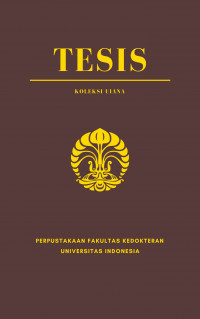Tesis
Uji pra-klinis Safety Nasogastric Tube yang memanfaatkan volume tidal dan pepsin untuk deteksi ketepatan pemasangan di saluran cerna Macaca facicularis = Preclinical trial of Safety Nasogastric Tube based on tidal volume and pepsin in detecting placement in gastrointestinal tract of Macaca facicularis.
Latar Belakang: Pada umumnya pemasangan selang nasogastrik (NGT) dilakukan tanpa bimbingan pencitraan, sehingga dapat terjadi malposisi selang.Malposisi ke paru-paru dapat terjadi mulai 0,3–15%. Metode verifikasi NGT hanya mendeteksi posisi selang setelah sebagian besar selang telah masuk ke dalam tubuh. Apabila terjadi kesalahan penempatan ke saluran pernapasan maka dapat menyebabkan kerusakan pada paru-paru. Alat Safety Nasogastric (SNGT) telah dibuat untuk mendeteksi posisi selang secara real time, sederhana dan murah. Tujuan penelitian yaitu membuktikan efektivitas dari SNGT dan enzim pepsinuntuk deteksi ketepatan pemasangan selang. Bahan dan Metode: Metode penelitian yang digunakan adalah eksperimental murni terhadap tiga ekor macaca fascicularisjantan (umur > 4 tahun dan berat 3-5 kg). Hewan dimasukan secara acakpada tiga kelompok yaitu selang SNGT dengan ukuran kantong udara 50% dari volume tidal (VT), selang SNGT dengan ukuran 100% VT, dan selang NGT konvensional.Masing-masing hewan dipasangkan selang lambung sebanyak 8 kali, sehingga total sampel sebanyak 24 kali pemasangan. Kemudian dilakukan pemeriksaan pepsin sebagai verifikasi akhir. Hasil: Selang SNGT 50% VT memiliki sensitivitas dan spesifisitas 100% dalam mendeteksi posisi selang. Sedangkan selang SNGT 100% VT memiliki sensitivitas 100% dan spesifisitas 87,5%. Terdapat perbedaan yang signifikan antara kantong udara selang SNGT 50% VT dengan SNGT 100% VT (p ≤ 0,05). Namun, tidak terdapat perbedaan yang signifikan antara ketepatan pemasangan selang SNGT 50% VT, SNGT 100% VT, dan NGT konvensional (p > 0,05). Enzim pepsin memiliki sensitivitas lebih baik (100%) dibandingkan kertas pH (91,66%) dalam mendeteksi selang lambung. Kesimpulan: Selang SNGT memiliki efektivitas yang cukup tinggi dalam mendeteksi posisi selang di saluran pernapasan dan pencernaan. Verifikasi posisi akhir selang dengan menggunakan enzim pepsin lebih baik dari pada kertas pH.
Kata Kunci: Selang Nasogastrik, Malposisi NGT, Enzim Pepsin
Background: In general, the insertion of a nasogastric tube (NGT) is done without imaging guidance, which tube malposition can occur. Malposition to the lungs may occur from 0.3–15%. The NGT verification method only detects the position of the tube after most of the tube has entered the body. However, misplacement of NGT into the respiratory tract can resulting damage to the lungs. Safety nasogastric tube (SNGT) has been created to detect the position of the tube in real time, simple and inexpensive.This study aims to prove the effectiveness of SNGT and pepsin enzymes in detecting the accuracy of tube placement. Materials and Methods: The research using experimental method on three male macaca fascicularis (age > 4 years and weight 3-5 kg). Animals were randomly assigned to three groups, namely the SNG tube with an air sac size of 50% of tidal volume (VT), the SNG tube with a size of 100% VT, and the conventional NG tube.Each animal was inserted with gastric tubes 8 times. Thus, we obtained a total of 24 samples.Then pepsin examination was carried out as final verification. Results: 50% VT SNGT tube has 100% sensitivity and specificity in detecting the position of the tube. While the SNGT tube 100% VT has a sensitivity of 100% and a specificity of 87.5%. There was a significant difference between air bag tube SNGT 50% VT and SNGT 100% VT (p 0.05). However, there was no significant difference between the accuracy of placement of 50% VT SNGT, 100% VT SNGT, and conventional NGT (p > 0.05). The pepsin enzyme has better sensitivity (100%) than pH paper (91.66%) in detecting the end position of the gastric tube. Conclusion: SNGT tube has a high effectiveness in detecting the position of the tube in the respiratory and digestive tracts. Verification of the end position of the tube using the enzyme pepsin is better than pH paper.
Keywords: Nasogastric Tube, NGT Malposition, Pepsin Enzyme
- Judul Seri
-
-
- Tahun Terbit
-
2021
- Pengarang
-
Sigit Mohammad Nuzul - Nama Orang
Busjra M. Nur - Nama Orang
Neng Tine Kartinah - Nama Orang - No. Panggil
-
T21347fk
- Penerbit
- Jakarta : Program Magister Ilmu Biomedik., 2021
- Deskripsi Fisik
-
xviii, 123 hal; ill; 21 x 30 cm
- Bahasa
-
Indonesia
- ISBN/ISSN
-
SBP Online
- Klasifikasi
-
NONE
- Edisi
-
-
- Subjek
- Info Detail Spesifik
-
Tanpa Hardcopy
| T21347fk | T21347fk | Perpustakaan FKUI | Tersedia |


Masuk ke area anggota untuk memberikan review tentang koleksi